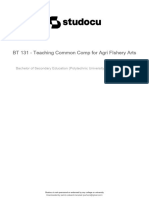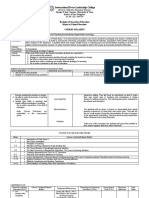Essay Exams - Instructions
Essay Exams - Instructions
Uploaded by
Arap MamboCopyright:
Available Formats
Essay Exams - Instructions
Essay Exams - Instructions
Uploaded by
Arap MamboOriginal Description:
Copyright
Available Formats
Share this document
Did you find this document useful?
Is this content inappropriate?
Copyright:
Available Formats
Essay Exams - Instructions
Essay Exams - Instructions
Uploaded by
Arap MamboCopyright:
Available Formats
INSTRUCTIONS FOR ESSAY EXAMS: You are presented with a hypothetical case plus research materials (provisions of law
and jurisprudence) that you may want to use in your work. The laws and jurisprudence accompanying the problems are designed to provide sufficient basis for preparing an excellent trial memorandum or legal opinion. But you are free to include such laws, rules and principles not provided that you feel will enhance your work. Choose the side of the dispute that you want to uphold and defend and prepare a trial memorandum in support of your side. Omit the case caption. Do not write more than four arguments. You have been given, apart from this Test Question, a Draft Pad, and an Answer Pad. Use the Draft Pad for making a draft of your memorandum. This will permit you to freely edit and rewrite your work. Editing and rewriting are essential to sound legal writing. The bells will be rung one hour before the end of the exam to signal the need for you to begin transferring your work to your Answer Pad. You may, of course, prefer to skip the preparation of a draft and write your essay directly on your Answer Pad. That is allowed. Quality of writing, not length is desired. You are free to jot notes or place helpful markings like underlines on the test questions and the enclosed materials. Corrections even on your final essay on the Answer Pad are allowed and will not result in any deduction. Still, it is advised that you write clearly, legibly and in an orderly manner. When the bell rings a second time to signal the end of the exam, your test questions, Draft Pad, and Essay Pad will be collected whether you are finished or not. The time pressure is a part of the exam. You will not be graded for a technically right or wrong answer but for the quality of your legal advocacy. The test is intended to measure your skills in: 1) communicating in English -- 20%; 2) sorting out the conflicting claims and extracting those facts that are relevant to the issue or issues in the case -- 15%; 3) identifying the issue or issues presented -- 15%; and 4) constructing your arguments and persuading your reader to your point of view -- 50%
You might also like
- CBRC CertificateDocument1 pageCBRC CertificateAlanlovely Arazaampong AmosNo ratings yet
- AjsjkcDocument8 pagesAjsjkcDani Mae ManzanilloNo ratings yet
- CHED Curriculum For General Education (Memorandum OrderDocument7 pagesCHED Curriculum For General Education (Memorandum OrderLudivine O AlmosaNo ratings yet
- PRC Complete Guidelines For LET ExamineesDocument3 pagesPRC Complete Guidelines For LET ExamineesMejai Curag Jr.No ratings yet
- Rubric-In-Scoring-Student-Teaching-Portfolio FinalDocument3 pagesRubric-In-Scoring-Student-Teaching-Portfolio FinaljaneNo ratings yet
- OBE Syllabus - Prof - Ed 13 Practice TeachingDocument7 pagesOBE Syllabus - Prof - Ed 13 Practice TeachingLito Mag-ampoNo ratings yet
- Outcomes-Based Education, The Tarlac State University TemplateDocument53 pagesOutcomes-Based Education, The Tarlac State University TemplateFhcRojoNo ratings yet
- Ched Form No. Gpr. A: (For New Programs)Document7 pagesChed Form No. Gpr. A: (For New Programs)FhcRojoNo ratings yet
- Compliance ChecklistDocument2 pagesCompliance ChecklistMik Oliamot100% (1)
- Leticia Cruz Siguenza: ObjectiveDocument6 pagesLeticia Cruz Siguenza: ObjectivecruzleticiaNo ratings yet
- CS Form No. 212 Revised Personal Data Sheet RennethDocument13 pagesCS Form No. 212 Revised Personal Data Sheet RennethSam MaulanaNo ratings yet
- Checklist of Requirement and Omnibus Sworn Statement FFF PDFDocument2 pagesChecklist of Requirement and Omnibus Sworn Statement FFF PDFHeizyl ann VelascoNo ratings yet
- Table of Specification in Educ 4Document3 pagesTable of Specification in Educ 4Jera ObsinaNo ratings yet
- Report1 (Constructing Test Items)Document17 pagesReport1 (Constructing Test Items)Ridz AmmangNo ratings yet
- University Memorandum 04 20 2020 PDFDocument3 pagesUniversity Memorandum 04 20 2020 PDFRey Niño GarciaNo ratings yet
- Ra 7686Document25 pagesRa 7686Marvz Espanillo LitanNo ratings yet
- Midterm ExamDocument3 pagesMidterm ExamJulaine Dumalanta PacisNo ratings yet
- SDO Camarines Norte: Facilitating Dreams, Valuing AspirationsDocument6 pagesSDO Camarines Norte: Facilitating Dreams, Valuing AspirationsSalve SerranoNo ratings yet
- PROF ED BOOSTER Check Mo ToDocument4 pagesPROF ED BOOSTER Check Mo TogiansulakisosuNo ratings yet
- BT 131 Teaching Common Comp For Agri Fishery ArtsDocument7 pagesBT 131 Teaching Common Comp For Agri Fishery ArtsPatrick ManatadNo ratings yet
- Syllabus For Readings in Philippine HistoryDocument11 pagesSyllabus For Readings in Philippine HistoryAnthony AlagonNo ratings yet
- PROF ED 112: Field Study 2: Course ModuleDocument77 pagesPROF ED 112: Field Study 2: Course ModuleMacos LabitaNo ratings yet
- Application Letter 1 AprilynbacoorDocument1 pageApplication Letter 1 AprilynbacoorBabylyn Tomes De Leon100% (1)
- Daily Lesson LogDocument1 pageDaily Lesson Logana mejicoNo ratings yet
- Application Letter FOR OJT 2Document1 pageApplication Letter FOR OJT 2Ivy BragatNo ratings yet
- Field Study 1 JeanDocument10 pagesField Study 1 JeanRaez RodilladoNo ratings yet
- Asian Civilization Syllabus 2009-10Document2 pagesAsian Civilization Syllabus 2009-10Roland ApareceNo ratings yet
- Module in Curriculum DevtDocument9 pagesModule in Curriculum DevtJudy Mae LawasNo ratings yet
- Cs Form No. 212 Revised Personal Data SheetDocument16 pagesCs Form No. 212 Revised Personal Data SheetPopoy ProvidogimayNo ratings yet
- Registry of Trainings AttendedDocument7 pagesRegistry of Trainings AttendedGifsy Robledo CastroNo ratings yet
- Cvsu Vision Cvsu Mission: Republic of The PhilippinesDocument10 pagesCvsu Vision Cvsu Mission: Republic of The PhilippinesRUTHY ANN BALBIN BEEd 2-1No ratings yet
- Application Form For The Oral DefenseDocument1 pageApplication Form For The Oral DefenseKath PalabricaNo ratings yet
- Edmil Jhon B. Ariques, ME: MembershipDocument2 pagesEdmil Jhon B. Ariques, ME: MembershipEdmil Jhon AriquezNo ratings yet
- Syllabus in FS2 Eng-4Document9 pagesSyllabus in FS2 Eng-4benz manalloNo ratings yet
- Physical Science (Specialization) Reviewer 494 Items With Rationalization PDFDocument118 pagesPhysical Science (Specialization) Reviewer 494 Items With Rationalization PDFKaren DellatanNo ratings yet
- Employers' FeedbackDocument49 pagesEmployers' FeedbackAnna Marie MarasiganNo ratings yet
- Module Ped 8 TCHNG Prof.Document156 pagesModule Ped 8 TCHNG Prof.lemuel sardualNo ratings yet
- Room Assignments - Secondary - English (Pagadian) PDFDocument50 pagesRoom Assignments - Secondary - English (Pagadian) PDFPhilBoardResultsNo ratings yet
- Resolution 2021 1363Document2 pagesResolution 2021 1363TheSummitExpress75% (8)
- CS Form No. 212 Revised Personal Data Sheet 2 - Corrected FinalDocument7 pagesCS Form No. 212 Revised Personal Data Sheet 2 - Corrected FinalMargie Gabo Janoras - DaitolNo ratings yet
- Dole Regional Office 10: Government Internship Program (Gip) Application FormDocument2 pagesDole Regional Office 10: Government Internship Program (Gip) Application FormAnonymous EvbW4o1U7No ratings yet
- FS-4102-Course Outline - Participation and Teaching AssistantshipDocument2 pagesFS-4102-Course Outline - Participation and Teaching AssistantshipJoy Anne EstrellonNo ratings yet
- Beed III-lesson 1.1-The Curricula in School Sept 4 2021Document7 pagesBeed III-lesson 1.1-The Curricula in School Sept 4 2021catherine r. apusagaNo ratings yet
- EDUC 55 Finals ReviewerDocument21 pagesEDUC 55 Finals ReviewerAyad Lydia MaeNo ratings yet
- Monitoring Instrument MAEd Programs - RQATDocument6 pagesMonitoring Instrument MAEd Programs - RQATAnonymous PcPkRpAKD5100% (1)
- LET ReviewerDocument10 pagesLET ReviewerMary Ann CabalejoNo ratings yet
- Bachelor of Technical Vocational Teacher Education: Sorsogon State College Education & Accountancy DepartmentDocument6 pagesBachelor of Technical Vocational Teacher Education: Sorsogon State College Education & Accountancy DepartmentRoleen CondeNo ratings yet
- QUESTIONS in Social Dimensions Let ReviewDocument8 pagesQUESTIONS in Social Dimensions Let ReviewWang Ming Ya100% (3)
- May 24,2016 Application Letter DepEdDocument1 pageMay 24,2016 Application Letter DepEdArjey MangakoyNo ratings yet
- SLRP TemplateDocument10 pagesSLRP TemplatePunang National High School 3091660% (1)
- Accreditation Standards For LibrariesDocument27 pagesAccreditation Standards For LibrariesSPCM LibraryNo ratings yet
- International Peace Leadership College: Bachelor of Secondary Education Major in Values Education Course SyllabusDocument6 pagesInternational Peace Leadership College: Bachelor of Secondary Education Major in Values Education Course SyllabusJosephine Aya100% (7)
- Presidential Decree No. 1006, S. 1976Document6 pagesPresidential Decree No. 1006, S. 1976Asela O. AriasNo ratings yet
- HM 112 Cost Control Lesson 1 Week 1Document19 pagesHM 112 Cost Control Lesson 1 Week 1LorydhelNo ratings yet
- Post - Test Module 1 - Session 7Document1 pagePost - Test Module 1 - Session 7Mariel GregoreNo ratings yet
- SCIENCE Reviewer With RationalizatonDocument119 pagesSCIENCE Reviewer With RationalizatonJerry AngtudNo ratings yet
- Annex 3 Letter of Availment For TES 3B - UpdatedDocument1 pageAnnex 3 Letter of Availment For TES 3B - UpdatedZra-zra CostillasNo ratings yet
- Chapter 7. Administring Scring Objctv Test and PaperDocument11 pagesChapter 7. Administring Scring Objctv Test and PaperRegina PalisocNo ratings yet
- Utilization of Test ResultsDocument77 pagesUtilization of Test ResultsNapdeo Natka Emuy Natad100% (1)
- Argumentative Essay ChecklistDocument5 pagesArgumentative Essay Checklistafmocrkjb100% (2)
- Philippine Politics Module 2 Lesson 1Document23 pagesPhilippine Politics Module 2 Lesson 1Arap MamboNo ratings yet
- Empowerment Tech Module 7Document21 pagesEmpowerment Tech Module 7Arap MamboNo ratings yet
- Entrepreneurship q2 Module 4Document12 pagesEntrepreneurship q2 Module 4Arap MamboNo ratings yet
- Entrepreneurship q2 Module 5Document12 pagesEntrepreneurship q2 Module 5Arap MamboNo ratings yet
- Applied Economics Module 2Document9 pagesApplied Economics Module 2Arap MamboNo ratings yet
- 2021 Foreign Service Officer (Fso) Examinations: Bfse@dfa - Gov.phDocument2 pages2021 Foreign Service Officer (Fso) Examinations: Bfse@dfa - Gov.phArap MamboNo ratings yet
- H61M-GS / H61M-S: User ManualDocument57 pagesH61M-GS / H61M-S: User ManualArap MamboNo ratings yet
- ApplicationForm2017 Final03Mar2017Document4 pagesApplicationForm2017 Final03Mar2017Arap MamboNo ratings yet
- Islam Today: Syed Abul Ala MawdudiDocument21 pagesIslam Today: Syed Abul Ala MawdudiArap MamboNo ratings yet




































































